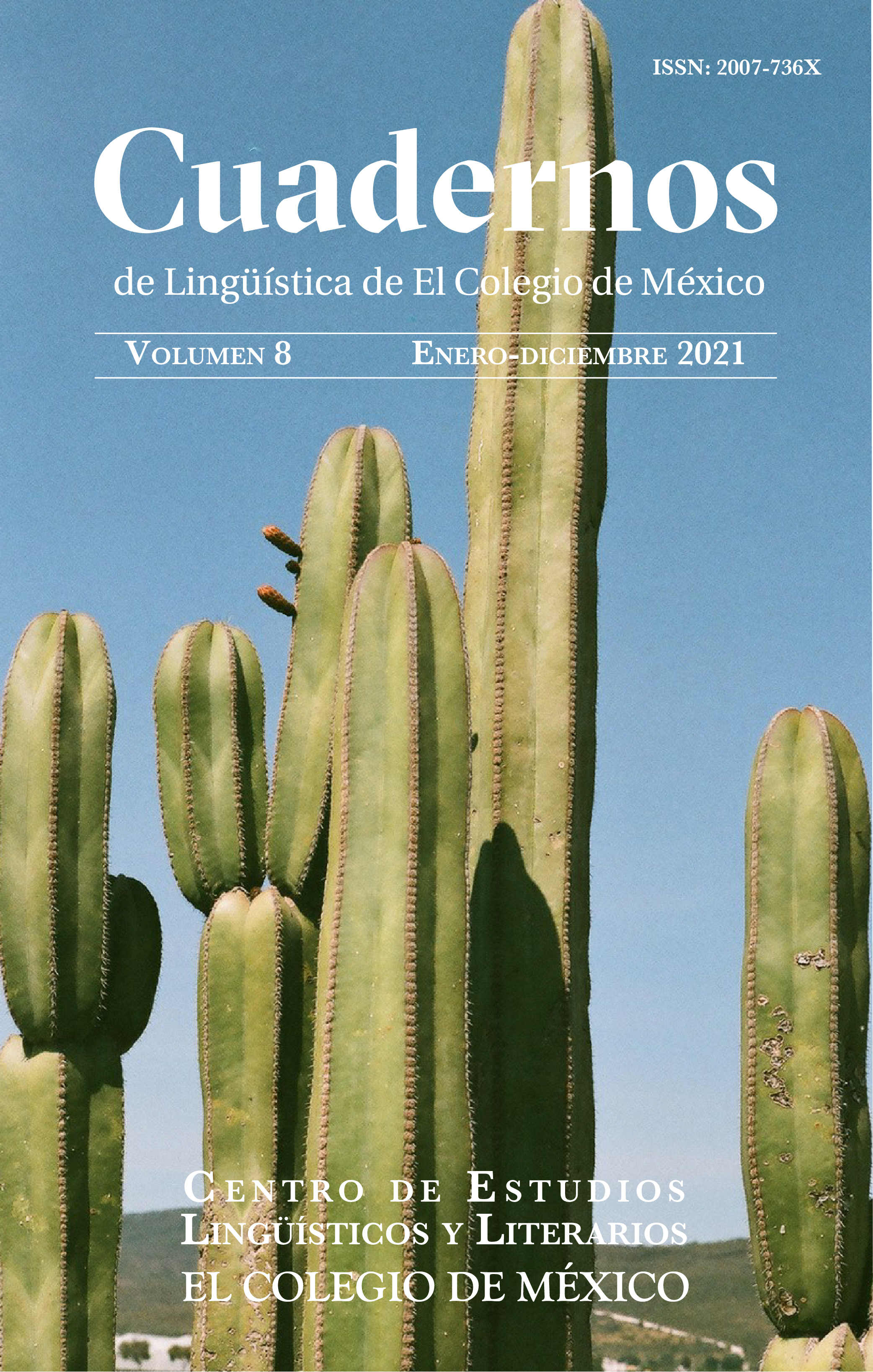Attenuation and expansion of ahorita in Mexico City, a change analyzed from the apparent time perspective
DOI:
https://doi.org/10.24201/clecm.v8i0.202Keywords:
temporal deixis, diminutives, semantic change, apparent time, sociolinguisticsAbstract
In Mexico City there are contexts in which ahorita (now + diminutive) cannot be interpreted as punctual or as close to the moment of speech. This behavior is investigated as a consequence of a semantic attenuation process, under the hypothesis of change in apparent time. Thereby, the speech of three generations of speakers from Mexico City was analyzed, and it was found that ahorita has spread to contexts incompatible with the features of punctuality and closeness to the moment of speech among younger speakers, displacing ahora (now) in certain cases.
Downloads
References
Agresti, Alan. 2013. Categorical data analysis (Wiley Series in Probability and Statistics 792). 3ra ed. Nueva Jersey: Wiley.
Agresti, Alan. 2019. An introduction to categorical data analysis (Wiley Series in Probability and Statistics). 3ra ed. Nueva Jersey: John Wiley & Sons.
Anthony, Laurence. 2016. AntConc. Tokio: Waseda University. http://www.laurenceanthony.net/.
Bailey, Guy & Wikle, Tom & Tillery, Jan & Sand, Lori. 1991. The apparent time construct. Language variation and change 3(03). 241–264. https://doi.org/10.1017/S0954394500000569.
Bello, Andrés. 2002. Gramática de la lengua castellana destinada al uso de los americanos. Alicante: Biblioteca virtual Miguel de Cervantes. http://www.cervantesvirtual.com/nd/ark:/59851/bmczk5c0.
Brisard, Frank. 2002. The English present. En Frank Brisard (ed.), Grounding: The epistemic footing of deixis and reference (Cognitive Linguistics Research 21), 251–297. Nueva York: De Gruyter Mouton.
Cartagena, Nelson. 1999. Los tiempos compuestos. En Bosque, Ignacio & Demonte, Violeta (eds.), Gramática descriptiva de la lengua española (Colección Nebrija y Bello), vol. 2. Madrid: Espasa Calpe.
Chambers, J. K. 2003. Patterns of variation including change. En Chambers, J. K. & Trudgill, Peter & Schilling-Estes, Natalie
(eds.), The handbook of language variation and change, 1–19. Edición electrónica. Oxford: Blackwell Publishing Ltd. https://doi. org/10.1111/b.9781405116923.2003.00020.x
Chambers, J. K. & Trudgill, Peter. 1998. Dialectology (Cambridge Textbooks in Linguistics). 2da ed. Cambridge: Cambridge University Press. https://doi.org/10.1017/CBO9780511805103
Comrie, Bernard. 1985. Tense (Cambridge Textbooks in Linguistics). Cambridge: Cambridge University Press.
Davies, Matt. 2012. A new approach to oppositions in discourse: The role of syntactic frames in the triggering of noncanonical oppositions. Journal of English linguistics 40(1). 41–73. https://doi.org/10.1177/0075424210385206.
Eguren, Luis J. 1999. Pronombres y adverbios demostrativos: Las relaciones deícticas. En Bosque, Ignacio & Demonte, Violeta (eds.), Gramática descriptiva de la lengua española, vol. 1. Madrid: Espasa Calpe.
Gaarder, A. Bruce. 1966. Los llamados diminutivos y aumentativos en el español de México. Modern language association.
García Fernández, Luis. 1999. Los complementos adverbiales temporales: La subordinación temporal. En Bosque, Ignacio & Demonte,Violeta (eds.), Gramática descriptiva de la lengua española, vol. 2. Madrid: Espasa Calpe.
Hornstein, Norbert. 1993. As time goes by: Tense and universal grammar. Cambridge: MIT Press.
Izutsu, Mitsuko Narita. 2008. Contrast, concessive, and corrective: Toward a comprehensive study of opposition relations. Journal of pragmatics 40(4). 646–675. https://doi.org/10.1016/j.pragma.2007.07.001.
Jollin-Bertocchi, Sophie. 2003. La polyvalence de l’adverbe maintenant. L’information grammaticale 97(1). 26–30. https://doi.org/10.3406/igram.2003.2627.
Jurafsky, Daniel. 1996. Universal tendencies in the semantics of the diminutive. Language 72(3). 533–578.
Klein, Wolfgang. 1994. Time in language (Germanic Linguistics).Nueva York: Routledge.
Krifka, Manfred. 2008. Basic notions of information structure. Acta linguistica Hungarica 55(3–4). 243–276. https://doi.org/10.1556/ALing.55.2008.3-4.2.
Labov, William. 1963. The social motivation of a sound change. WORD 19(3). 273–309. https://doi.org/10.1080/00437956.1963.11659799.
Labov, William. 2006. The social stratification of English in New York City. 2da ed. Cambridge: Cambridge University Press.
Langacker, Ronald W. 2008. Cognitive grammar: A basic introduction. Nueva York: Oxford University Press.
Lee, Eunhee. 2017. Discourse properties of now. Journal of linguistics 53(03). 613–640. https://doi.org/10.1017/S0022226715000432.
Levinson, Stephen C. 1983. Pragmatics (Cambridge Textbooks in Linguistics). Cambridge: Cambridge University Press.
Lyons, John. 1977. Semantics. Vol. 2. Cambridge: Cambridge University Press.
Malaver, Irania. 2017. Ahorita: lexicalización y cambio lingüístico en la comunidad de habla caraqueña. Nueva revista de filología hispánica 65(1). https://doi.org/10.24201/nrfh.v65i1.2828. http://nrfh.colmex.mx/index.php/nrfh/article/view/2828
Mangiafico, Salvatore S. 2016. Summary and analysis of extension program evaluation in R. Nueva Jersey: Rutgers Cooperative Extension.
Martín Butragueño, Pedro & Lastra, Yolanda (eds.). 2011. Corpus sociolingüístico de la ciudad de México. Vol. 1, México: El Colegio de México.
Martín Butragueño, Pedro & Lastra, Yolanda (eds.). 2012. Corpus sociolingüístico de la ciudad de México. Vol. 2, México: El Colegio de México.
Martín Butragueño, Pedro & Lastra, Yolanda (eds.). 2015. Corpus sociolingüístico de la ciudad de México. Vol. 3, México: El Colegio de México.
McDonald, John H. 2014. Handbook of biological statistics. 3ra ed. Baltimore: Sparky House Publishing.
Mendoza, Martha. 2011. Size matters: Grammaticalization, metaphor, and the Spanish diminutive. Estudios de lingüística aplicada 29(54). 135–157.
Murphy, M. Lynne, Jones, Steven & Koskela, Anu. 2015. Signals of contrastiveness: But, oppositeness, and formal similarity in parallel contexts. Journal of English linguistics 43(3). 227–249. https://doi.org/10.1177/0075424215591852.
Nikiforidou, Kiki. 2010. Viewpoint and construction grammar: The case of past + now. Language and Literature 19(3). 265–284. https://doi.org/10.1177/0963947010370253.
R Core Team. 2015. R: A language and environment for statistical computing. Viena: R Foundation for Statistical Computing. https://www.R-project.org/.
RAE & ASALE. 2009. Nueva gramática de la lengua española. 2 vols. Madrid: Espasa Libros.
Rallides, Charles. 2013. Tense aspect system of the Spanish verb as used in cultivated Bogotá Spanish. Hague: De Gruyter Mouton. http://qut.eblib.com.au/patron/FullRecord.aspx?p=3043157
Rooij, Robert van & Schulz, Katrin. 2017. Topic, focus, and exhaustive interpretation. En Lee, Chungmin & Kiefer, Ferenc & Krifka, Manfred (eds.), Contrastiveness in information structure, alternatives and scalar implicatures, vol. 91, 63–82. Cham: Springer International Publishing. https://doi.org/10.1007/978-3-319-10106-4_4. http://link.springer.com/10.1007/978-3-319-10106-4_4
Sharpe, Donald. 2015. Your chi-square test is statistically significant: Now what? Practical Assessment, Research & Evaluation 20(8). 1–10.
Tagliamonte, Sali A. 2006. Analysing sociolinguistic variation. Cambridge: Cambridge University Press.
Traugott, Elizabeth Closs. 2006. Semantic change: Bleaching, strengthening, narrowing, extension. En Brown, Keith (ed.), Encyclopedia of language and linguistics, vol. 11, 124–131. 2da ed. Oxford: Elsevier.
Yllera, Alicia. 1999. Las perífrasis verbales de gerundio y participio. En Bosque, Ignacio & Demonte, Violeta (eds.), Gramática descriptiva de la lengua española (Colección Nebrija y Bello), vol. 2. Madrid: Espasa Calpe.
Published
How to Cite
-
Abstract879
-
PDF (Español)386
-
XML (Español)7
-
EPUB (Español)93
-
Kindle (Español)88
-
MP3 (Español)25
Issue
Section
License
Copyright (c) 2021 Daniel Granados

This work is licensed under a Creative Commons Attribution-NonCommercial-NoDerivatives 4.0 International License.
Authors retain copyright of their work and are free to disseminate it, make copies for any use, and/or deposit in any repository or archive of their choice, but they grant Cuadernos de Lingüística de El Colegio de México the right to publish the work for the first time. Authors agree to acknowledge Cuadernos de Lingüística de El Colegio de México as the site of original publication of their article / note / review through proper citation.
Articles appearing in Cuadernos de Lingüística de El Colegio de México are made available to readers under a Attribution-NonCommercial-NoDerivatives 4.0 International.









